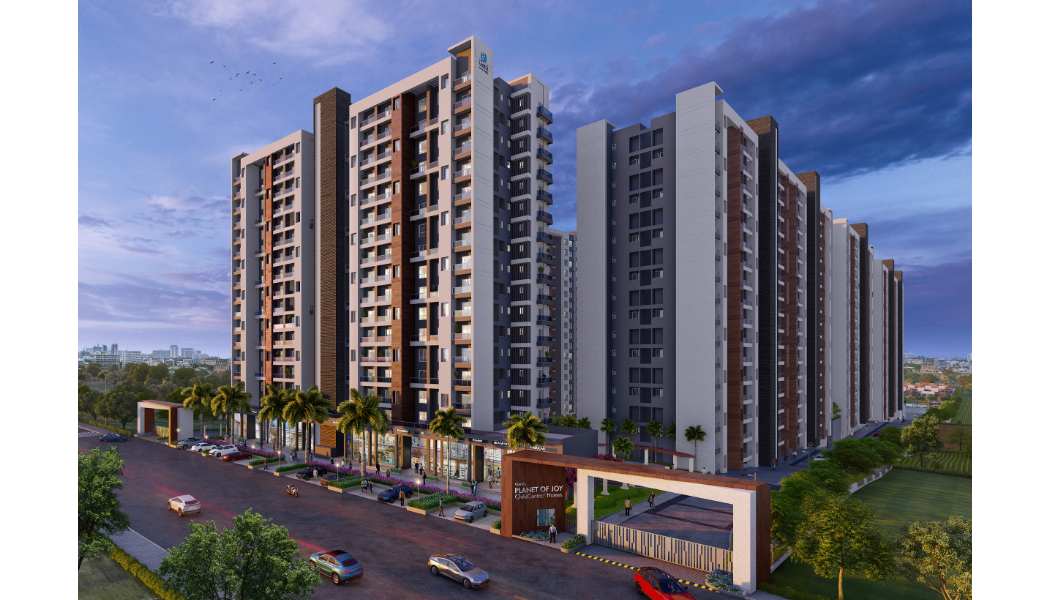Pune Real Estate: Overall increase of 8.74% in home prices; larger apartments at above 1,400 sq ft see a 38% increase in sales volumes

Pune, 3rd January 2024: Gera Developments, the pioneers of real estate business, and the award-winning creators of premium residential and commercial projects in Pune, Goa and Bengaluru, today released the January 2024 edition of their bi-annual report titled, ‘The Gera Pune Residential Realty Report’. It is based on primary and proprietary research conducted by Gera Developments, and covers all existing projects in a 30-km radius of the city centre. The report is an outcome of the longest-running, census-based study of the residential markets of Pune.
According to the latest edition, The Gera Pune Residential Realty Report, for the period of Jun to Dec 2023, all parameters look strong and stable. During this period, the rise in salaries and disposable income have more than compensated for the increase in interest rates.
The average prices of homes for sale reached a new high of Rs 5,938 per sq ft, at about 17% higher than the previous peak of Rs 5,096 in Dec 2015. Between Dec 2022 and Dec 2023, home prices rose by 8.74%, where the average rates were at Rs 5,461 per sq ft in Dec 2022, and went up to Rs 5,938 per sq ft in Dec 2023.
Fresh supply launched in the last six months remains at an elevated level, increasing by 9% to 50,343 units over the six months ended Dec 2023 – in the six months ending Jun 2023, they were at 46,007 units. However, for the full year, new launches have gone down by 6%, i.e. to 96,350 units in 2023 from 1,02,572 units in 2022. The UDCPR continues to be awaited for the PMRDA regions. Once the UDCPR is made applicable to the PMRDA areas, the overall development potential will go up between 2 and 2.5 times. This will potentially, substantially increase supply.
The overall inventory available for sale is healthy at 73,379 homes i.e., 23.63% of the total inventory under development, at 310,567 homes. The current unsold inventory is about 9.31 months of the current annual sales volumes. There is an increase from in inventory overhang, at 8.37 months in Dec 2022, substantially lower than that in 2018, when the overhang was 11.43 months. The gross inventory of approx. 3.1 lakh homes has been reasonably stable since Dec 2015. The replacement ratio (which measures the ratio of new inventory added to the inventory sold during a period) is at 1.06, indicating that supply added to the market was 6% more than the sales during the year. The market is generally considered buoyant, however, the first signs of difficulty are seen when the replacement ratio starts to rise. The present number at 6% is not a major concern, however, if substantial new inventory is added, and sales numbers do not rise, the market could face headwinds in due course.
Speaking on the findings of The Gera Residential Realty Report January 2024 edition, and the latest trends in Pune’s residential real estate market, Rohit Gera, Managing Director, Gera Developments, said, “From a pricing perspective, the increase of almost 9% in the last year looks strong. The fact that overall sales numbers have come down, and the new inventory added is 6% more than the sale numbers of the previous year, is reason to be a bit cautious. There is a lot of potential inventory waiting in the wings for the UDCPR to be made applicable in the PMRDA region. This will potentially, substantially add to the overall supply. We continue with our cautiously optimistic view of the market as we look at our land acquisition and project launch strategy for 2024.”
Here are the key highlights of The Gera Pune Residential Reality Report, encompassing trends from Dec 2022 to Dec 2023:
#1: New launches reduce by 6% on an annual level, but increase by 9% in the last 6 months
96,350 units were launched in 2023, compared to 1,02,572 units in 2022. At 96,350 units, the pace of new launches is still very healthy, and the decline needs to be seen in the context of the high base of 1Lakh+ units launched in 2022. Before 2022, only in 2014 and 2015 have we seen over 1Lakh units being launched in a single calendar year.
Apart from the value segment (i.e. units priced between Rs 4,792 per sq ft to Rs 5,988 per sq ft), which has seen an increase of 12% over 2022, there is a reduction in all the other segments – led by the luxury segment (i.e. units priced at Rs 8,982 per sq ft & above), where new launches have dropped by 34% from 8,764 units in 2022, to 5,753 units in 2023. However, launches in the luxury segment are still higher compared to all the 7 years prior to 2022. The story for Premium Plus homes (i.e units priced between Rs 7,187 per sq ft to 8,982 per sq ft) which have seen a drop of 3.4% is also similar to Luxury homes. In all the 7 years prior to 2022, the new launches have been lower compared to 2023. The demand for Luxury and Premium Plus still continues to be healthy.
#2: Inventory available for sale increases by 1.73%
The current inventory available for sale at 73,379 homes is classified into 4 stages based on construction status- Early, Mid, End, and Ready. Early-stage inventory constitutes ~33% of all available units for sale as of Dec 2023, and it has seen the maximum increase of 8% over 2022. As of Dec 2023, Early-stage units constituted 23,810 units, compared to 22,131 units in Dec 2022.
#3: Sales Velocity has decreased by 8.6% on a yearly level
Sales Velocity has reduced by 8.6% at a yearly level, driven primarily by a 22% reduction in sales in units sized 1,000 sq ft & below. On the other side of the spectrum, units sized 1,400 sq ft and above have seen a significant increase of 38% in the offtake, from 11,942 units in 2022 to 16,475 units in 2023.
#4: Market continues its trend towards larger projects
At 180, as of Dec 2023, the number of large projects (those with more than 500 units) is at an all-time high. Over the last 5 years, this number has increased from 148 projects in Dec 2019 to 180 projects in Dec 2023. In Dec 2019, these 148 projects constituted 4.1% out of the total of 3,490 projects being developed. In Dec 2023, the 180 projects constituted 7.78% of the total 2,314 projects under development.
#5: Affordability reduces to 3.81x – from 3.56 in Dec 2021 to 3.71 in Dec 2022
Homes have become marginally less affordable. However, on an overall basis, affordability continues to be very strong at 3.81x annual income. While interest rates continue to remain unchanged over the last six months, over time, interest rates have increased, while incomes have risen – thereby significantly increasing affordability. However, this cycle might have bottomed out, with interest rates and home prices rising at a significant rate. Input costs have forced developers to raise prices. Increasing interest rates and inflation get the home buyer less per rupee, and hence the affordability equation—though still healthy—can nonetheless create headwinds for developers.
As per the report, in Jun 2011, the salary needed to buy a 1,000-sqft home was 4.83 times the cost of the home. This peaked in Dec 2014, when the salary needed to buy the same 1,000-sqft home at the increased salary and increased rates was 5.27 times. Since Dec 2014, the consistent reduction in interest rates and home prices, along with salary increments, have led to a situation where the house cost for a 1,000-sqft home is now at 3.81 times the salary. However, affordability has decreased from 3.71 in Dec 2022, to 3.81 in Dec 2023. This is primarily due to the combined increase in interest rates from 9.6% to 9.85% in the previous period, and prices rising from Rs 5,461 per sq ft to Rs 5,938 per sq ft.
After witnessing furious growth in the past in terms of sales and new launches, markets have streamlined at sustainable levels. Prices have increased by 8.74% across all projects over the last 12 months. While yearly growth in offtake and new launches remains healthy—at a yearly basis—both have decreased respectively by 8.6% and 6%. Larger-sized homes continue to do well in terms of offtake, and find favour with customers. The replacement ratio is 1.06, indicating that supply is marginally greater than demand, while inventory overhang is <10 months, reiterating that market fundamentals remain strong in the near- to medium-term.









